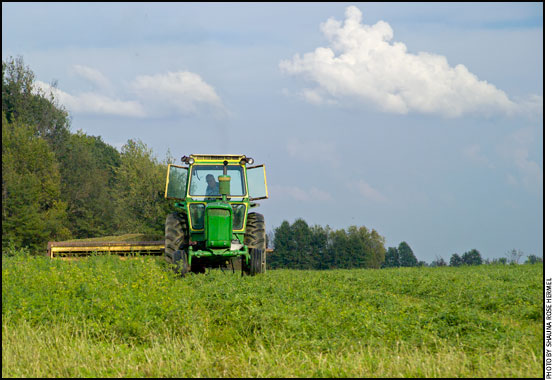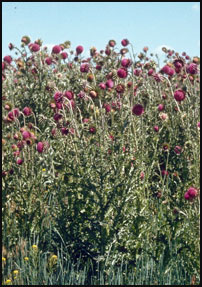HEALTH & NUTRITION...

Beef Cows Don't Need Dairy Quality
Alfalfa can be a cost-effective protein supplement, but too much protein can be problematic.
Alfalfa is an excellent source of protein for cattle, but rich alfalfa hay can create health problems, including scours and enterotoxemia, for young calves if their mamas are milking too heavily during the first couple months of lactation. If calves are born early and cows are fed hay when the calf is young, grass hay is healthier for the herd than alfalfa, says veterinarian Ron Skinner, a seedstock producer at Hall, Mont. Read more.
Organic Selenium Improves Meat Characteristics
According to a recent study performed at Padova University, Padua, Italy, on beef cattle, organic selenium supplementation (Alkosel® 3000 from Lallemand) can improve meat processing quality and organoleptic qualities, when compared to mineral selenium. The trial showed that organic selenium enhanced antioxidant status and improved meat tenderness and visual appearance, in line with consumer expectations, and reduced drip loss for the processor. Read more.
U of M Veterinary Medical Center Launches Nation's First Animal Trauma Center
New center to serve as model for other universities and veterinary medical centers.
Examples of trauma cases capable of being treated by the Animal Trauma Center include injuries resulting from moving vehicle accidents, major falls, bite wounds, and smoke or chemical inhalation. In addition, most of the region's police department K9 units rely on the VMC to provide care for canine officers injured in the line of duty. Read more.
 Farmer Finds Unusual Forage Grass
Farmer Finds Unusual Forage Grass
Meadow fescue is very winter-hardy and persistent; won't poison livestock.
A U.S. Department of Agriculture (USDA) grass breeder has rediscovered a forage grass that seems just right for today's intensive rotational grazing.
A farmer's report of an unusual forage grass led Michael Casler, an Agricultural Research Service (ARS) geneticist at the agency's U.S. Dairy Forage Research Center in Madison, Wis., to identify the grass as meadow fescue. Meadow fescue has been long forgotten, although it was popular after being introduced about 50-60 years before tall fescue. Read more.

Rick Rasby
Ridin’ Herd
Minerals for beef cows 101
Many mineral elements and vitamins are essential nutrients with very specific functions. Mineral elements and vitamins are required in small amounts, but a mineral element or vitamin deficiency could potentially result in reductions in growth and reproduction in otherwise adequately nourished beef cows and calves. Provide for mineral deficiencies with an economical mineral supplementation strategy. Supplementing diets at concentrations in excess of requirements greatly increases cost. Read more.
Spring Pasture Maintenance
 Control musk thistle early.
Control musk thistle early.
If you've had problems with musk thistle on your land in the last year and intend to apply chemical control, early spring is a good time to check for new growth of this noxious weed, said a University of Missouri Extension agronomy specialist.
"For optimal control, herbicides should be applied when musk thistle is in the rosette stage, typically in the fall or early spring," said Travis Harper. "Landowners should walk fields in the spring or fall looking for these rosettes." The musk thistle rosette is a flat circle of leaves that can reach a diameter of 2 feet or more.
Timing is critical. "Spraying after the plant has bolted and/or produced a flower is too late to achieve good control," Harper said. "Typically, the plant will survive, flower and produce viable seed." Read more.
Importance of Postcalving Nutrition
If a cow is lactating, she needs a much higher level of protein and energy than when she is pregnant. According to Shannon Williams, Lemhi County Extension agent (Salmon, Idaho) the thing producers really need to remember is that during the 60 days following calving, they are asking the cow to produce milk, repair her uterus and breed back again. "This requires an extreme amount of energy and nutrients," she says.
If a cow is in poor body condition when she calves, she doesn't have a very good chance to prepare for rebreeding while she's producing milk for her new calf. She may continue to lose weight, even if you increase her nutrient levels, and fail to cycle on time. This is a crucial phase in her production cycle, and if she is a young cow (still growing), her needs for energy and protein will be even greater than that of an older cow.
"The important things are to feed cattle appropriately for their age and stage of gestation, and make sure they have good feed during not only the last trimester but also the first 60 days after they calve. Their demands increase tremendously at that time."
Even if the cows came through pregnancy in good body condition, you don't want them to lose ground after calving.
"They can always rob a little from their backfat if they were in good flesh at calving, but you may pay for this later if you don't catch the weight loss soon enough," says Williams. Don't just turn them out to grass and stop feeding them if the grass isn't quite ready yet. They may lose too much weight and not breed back quickly.
Cattle Diseases: Common Conditions/Terms
Click here for a list of common conditions and terms related to beef cattle diseases, such as anaplasmosis, brucellosis, BVD, E. coli, IBR and others.
[Click here to go to the top of the page.]













